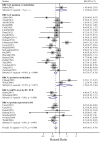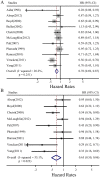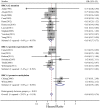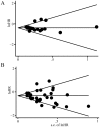The role of BRCA status on the prognosis of patients with epithelial ovarian cancer: a systematic review of the literature with a meta-analysis
- PMID: 24788697
- PMCID: PMC4006804
- DOI: 10.1371/journal.pone.0095285
The role of BRCA status on the prognosis of patients with epithelial ovarian cancer: a systematic review of the literature with a meta-analysis
Abstract
Objective: The role of BRCA dysfunction on the prognosis of patients with epithelial ovarian cancer (EOCs) remains controversial. This systematic review tried to assess the role of BRCA dysfunction, including BRCA1/2 germline, somatic mutations, low BRCA1 protein/mRNA expression or BRCA1 promoter methylation, as prognostic factor in EOCs.
Methods: Studies were selected for analysis if they provided an independent assessment of BRCA status and prognosis in EOC. To make it possible to aggregate survival results of the published studies, their methodology was assessed using a modified quality scale.
Results: Of 35 evaluable studies, 23 identified BRCA dysfucntion status as a favourable prognostic factor. No significant differences were detected in the global score of quality assessment. The aggregated hazard ratio (HR) of overall survival (OS) of 34 evaluable studies suggested that BRCA dysfunction status had a favourable impact on OS (HR = 0.69, 95% CI 0.61-0.79), and when these studies were categorised into BRCA1/2 mutation and low protein/mRNA expression of BRCA1 subgroups, all of them demonstrated positive results (HR = 0.67, 95% CI: 0.57-0.78; HR = 0.62, 95% CI: 0.51-0.75; and HR = 0.51, 95% CI: 0.33-0.78, respectively), except for the subgroup of BRCA1 promoter methylation (HR = 1.59, 95% CI: 0.72-3.50). The meta-analysis of progression-free survival (PFS), which included 18 evaluable studies, demonstrated that BRCA dysfunction status was associated with a longer PFS in EOC (HR = 0.69, 95% CI: 0.63-0.76).
Conclusions: Patients with BRCA dysfunction status tend to have a better outcome, but further prospective clinical studies comparing the different BRCA statuses in EOC is urgently needed to specifically define the most effective treatment for the separate patient groups.
Conflict of interest statement
Figures





References
-
- Jemal A, Siegel R, Xu J, Ward E (2010) Cancer statistics, 2010. CA Cancer J Clin 60: 277–300. - PubMed
-
- Ovarian cancer, five-year stage-specific relative survival rates (2004–2008). J Natl Cancer Inst 103: 1287. - PubMed
-
- Rubin SC, Benjamin I, Behbakht K, Takahashi H, Morgan MA, et al. (1996) Clinical and pathological features of ovarian cancer in women with germ- line mutations of BRCA1. New England Journal of Medicine 335: 1413–1416. - PubMed
-
- Vencken PM, Kriege M, Hoogwerf D, Beugelink S, van der Burg ME, et al. (2011) Chemosensitivity and outcome of BRCA1- and BRCA2-associated ovarian cancer patients after first-line chemotherapy compared with sporadic ovarian cancer patients. Ann Oncol 22: 1346–1352. - PubMed
Publication types
MeSH terms
Substances
LinkOut - more resources
Full Text Sources
Other Literature Sources
Medical
Miscellaneous

